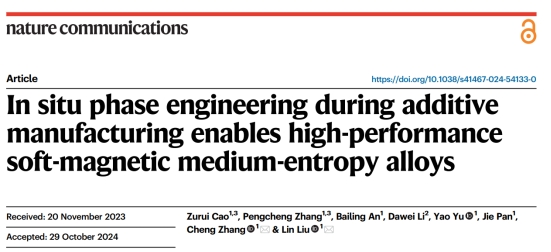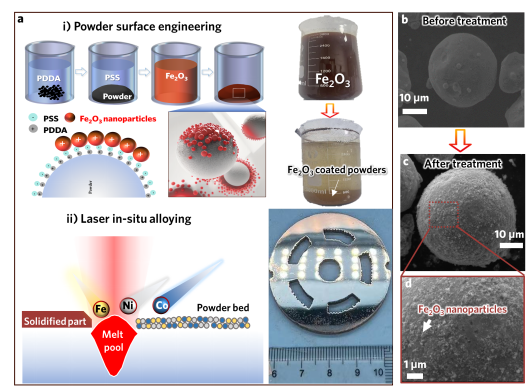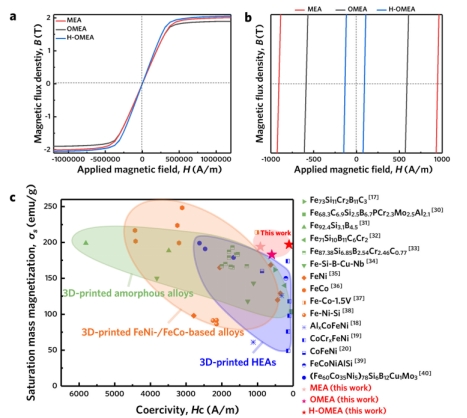On November 11, a research paper titled “In situ phase engineering during additive manufacturing enables high-performance soft-magnetic medium-entropy alloys” was published online in Nature Communications. The research was jointly conducted by Professor Liu Lin and Professor Zhang Cheng from the School of Materials Science and Engineering. Professor Zhang Cheng and Professor Liu Lin from HUST were co-corresponding authors, with master’s graduate Cao Zurui and postdoctoral fellow Zhang Pengcheng from HUST serving as co-first authors.

Soft-magnetic alloys are crucial functional materials in modern science, technology, and industry, particularly in the fields of electricity, electronics, and energy. As technology advances rapidly, the performance demands for soft-magnetic materials in next-generation electrical devices have become more stringent. Recently, multi-component alloys with superior soft-magnetic properties have attracted considerable attention due to their potential to replace traditional soft-magnetic alloys. However, the poor formability of multi-component alloys poses a significant challenge for conventional forming techniques, especially when manufacturing complex-shaped soft-magnetic components.
Additive manufacturing (3D printing) is an emerging processing method based on layer-by-layer deposition, enabling the fabrication of complex-shaped soft-magnetic components. However, current research on additive manufacturing of multi-component soft-magnetic alloys often struggles to meet the combined requirements of high saturation magnetization, low coercivity, and low loss. Professor Zhang Cheng and others in Liu Lin’s Group have conducted extensive research in areas such as composition design of soft-magnetic disordered alloys, surface modification of powders, optimization of additive manufacturing processes, and the evolution of microstructure and their impact on magnetic properties. They proposed an innovative in-situ phase engineering strategy, which involves modifying elemental powders with nano-oxides. This strategy enables in-situ phase structure engineering (from BCC/FCC dual-phase to FCC single-phase) during the laser additive manufacturing process, optimizing soft-magnetic properties and overcoming the performance limitations of existing multi-component soft-magnetic alloys.
This study focuses on a high-saturation magnetization, dual-phase, non-equimolar FeCoNi high-entropy alloy as the base material and optimizes its phase structure and magnetic properties using the in-situ phase engineering strategy. The process involves three main steps (Fig. 1): First, coating the surface of elemental powders with nano-Fe2O3 particles; second, using laser 3D printing to process the material and induce in-situ phase transitions (BCC/FCC → FCC, Fe2O3 → FeO); finally, applying high-temperature heat treatment to further refine the microstructure and magnetic properties. This approach successfully produces a single FCC-structured high-entropy alloy/FeO composite material with exceptional soft-magnetic properties, including a saturation magnetization of 2.05 T and a coercivity as low as 115 A/m, outperforming most additively manufactured soft-magnetic alloys reported in the literature (Fig. 2). Additionally, the inclusion of FeO particles significantly enhances the resistivity, doubling the value of samples without the nanoparticles, thereby reducing iron losses. The research shows that the BCC-phase nanocrystals and the FCC/BCC phase boundaries significantly hinder magnetic domain motion, whereas coarse FCC-phase grains and FeO/FCC semi-coherent phase boundaries reduce this hindrance, leading to a substantial decrease in coercivity. The innovative strategy presented not only provides new insights into structural tailoring for high-performance soft-magnetic alloys in additive manufacturing but also has significant engineering implications for the manufacturing and application of high-frequency, high-efficiency motor cores.

Fig. 1 Preparation of Fe2O3 coated powders and 3D printed samples

Fig. 2 The magnetic properties of samples prepared via in situ phase engineering and comparison with 3D printed soft-magnetic alloys from literature
Paper link: https://www.nature.com/articles/s41467-024-54133-0
Written by: Cheng Zhang
Edited by: Chang Wen, Peng Yumeng
